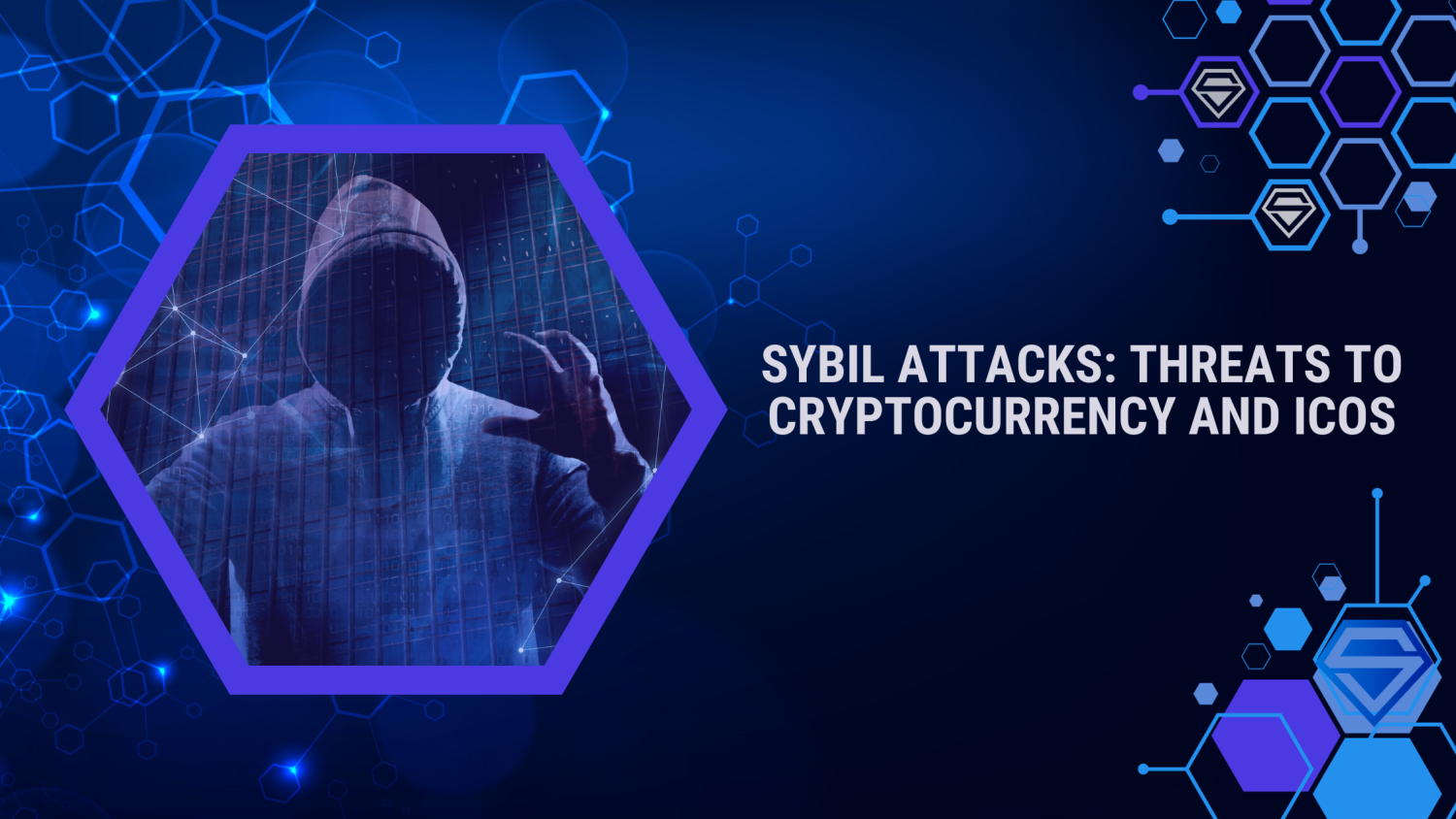
07. November, 2023
What is Sybil Attacks? Why is it a Threat to Cryptocurrency and ICOs?
Cryptocurrencies and Initial Coin Offerings (ICOs) have revolutionized the financial landscape, offering innovative ways to transact and invest. However, they are not immune to a subtle yet menacing threat known as Sybil attacks.
In this article, we’ll unravel the mystery behind Sybil attacks and explore how they can wreak havoc on digital assets and the technologies that underpin them.
What Are Sybil Attacks?
Picture this: attackers seamlessly multiply their influence within a system by creating numerous fake identities. These fabricated personas can be leveraged to manipulate, disrupt, and exploit various aspects of a network, posing a significant challenge to security.
In the context of cryptocurrencies and ICOs, Sybil attacks manifest when malicious actors fabricate multiple accounts or identities to gain disproportionate control or influence within a given ecosystem.
Let’s delve deeper to understand how they can impact these realms.
Manipulating Markets with Sybil Attacks
Sybil attacks can be a potent tool for market manipulation. For instance, a malicious actor can exploit their numerous fake identities to create artificial demand for a cryptocurrency, artificially inflating its price and then selling it for profit.
Conversely, they can use their fabricated personas to orchestrate a coordinated effort to drive down a cryptocurrency’s price, enabling them to acquire it at a significant discount.
Stealing Funds through Deception
Sybil attacks can also be used for nefarious purposes, such as fund theft. An attacker can employ multiple identities to sway votes in favor of withdrawing funds from a cryptocurrency exchange. By doing so, they can siphon off substantial sums of money or assets. Furthermore, they might concoct a counterfeit ICO, duping unsuspecting investors into pouring their money into a fraudulent venture.
Disrupting Operations for Chaos
In the realm of cryptocurrencies, maintaining network integrity is vital. Sybil’s attacks can disrupt these operations by casting a shadow of uncertainty. An attacker might use their fabricated personas to vote on proposals aimed at changing the rules of a cryptocurrency or to flood a network with bogus transactions, hampering its efficiency and reliability.
Real-World Sybil Attack Examples
Sybil attacks have been used to exploit vulnerabilities in the cryptocurrency and ICO landscape in a variety of ways. Here are two notable examples:
Ethereum Classic (ETC) Attack (2016)
In 2016, an attacker orchestrated a Sybil attack on the Ethereum Classic (ETC) network. The attacker created multiple fake wallets and used them to gain control of the majority of ETC’s hash rate. This allowed them to double-spend ETC and steal millions of dollars from exchanges.
In a double-spend attack, an attacker exploits the fact that cryptocurrency transactions are not finalized until they are confirmed by a certain number of miners. The attacker creates two transactions, one that sends funds to themselves and another that sends the same funds to someone else. The attacker then broadcasts the transaction that sends funds to themselves to a group of miners they control.
Once the transaction is confirmed by these miners, the attacker broadcasts the other transaction to the rest of the network. The network will then accept both transactions since they were both valid when they were broadcast.
In the ETC attack, the attacker used their control of most of the network’s hash rate to double-spend ETC. They first deposited ETC into an exchange and then sent it to themselves using a fake wallet address. They then broadcast the transaction that sent the ETC to their fake wallet to the group of miners they controlled. Once the transaction was confirmed by these miners, the attacker withdrew the ETC from the exchange. The exchange was left with a balance that did not exist, since the ETC had already been spent.
EOS ICO (2017)
In 2017, an attacker utilized multiple fake accounts to vote for their preferred block producers during the EOS ICO. This enabled them to seize control of the EOS network, causing disruptions to its operations.
Block producers are responsible for validating transactions and adding them to the blockchain. In the EOS ICO, users could vote for their preferred block producers to earn rewards. The attacker created multiple fake accounts and used them to vote for their preferred block producers. This allowed them to gain control of the EOS network and disrupt its operations.
The attacker used their control of the EOS network to prevent legitimate block producers from validating transactions. This caused a backlog of transactions to build up on the network, making it difficult for users to send and receive EOS. The attacker also used their network control to freeze accounts and steal EOS from users.
Preventing Sybil Attacks
Sybil attacks can have a devastating impact on cryptocurrency networks and ICOs, leading to double spending, fraud, and disruption. Preventing Sybil attacks is crucial to safeguarding the integrity of these systems.
Here are some key strategies for preventing Sybil attacks:
Identity Verification
One way to prevent Sybil attacks is to require users to verify their identities. This can be done through a variety of methods, such as government-issued IDs, a Know Your Customer (KYC) process, or decentralized identity solutions. Identity verification can help prevent malicious actors from creating multiple fake accounts to gain control of a network.
Reputation and Stake-Based Systems
Another way to prevent Sybil attacks is to use a reputation or stake-based system. In a reputation system, users are rewarded for their positive contributions to the network, such as participating in governance or validating transactions. This gives users with a good reputation more influence in the network, making it more difficult for attackers to control the network with fake accounts.
In a stake-based system, users are rewarded for holding a certain amount of the network’s cryptocurrency. This gives users with a larger stake more influence in the network, making it more difficult for attackers to control the network with fake accounts.
Hybrid Approaches
A hybrid approach that combines identity verification and reputation/stake-based systems can provide a robust defense against Sybil attacks. This creates multiple layers of protection, making it more difficult for attackers to succeed.
Here are some specific examples of how these strategies are being used to prevent Sybil attacks in the cryptocurrency and ICO space:
Additional Considerations
In addition to the strategies described above, there are a number of other things that can be done to prevent Sybil attacks. These include:
- Using a variety of consensus mechanisms: Different consensus mechanisms have different strengths and weaknesses when it comes to preventing Sybil attacks. By using a variety of consensus mechanisms, cryptocurrency networks can make it more difficult for attackers to succeed.
- Implementing security measures at the protocol level: Cryptocurrency protocols can be designed with security features that make it more difficult to launch Sybil attacks. For example, protocols can limit the rate to prevent attackers from creating too many accounts or sending too many transactions.
- Educating users about Sybil attacks: Users need to be aware of the dangers of Sybil attacks and how to protect themselves. Cryptocurrency projects and exchanges should educate their users about Sybil attacks and how to avoid them.
In Conclusion
Sybil’s attacks pose a substantial threat to the cryptocurrency and ICO ecosystem. Understanding their inner workings and implementing preventative measures is vital for investors, developers, and all stakeholders.
By doing so, we can fortify these innovative technologies against the clandestine threats that seek to undermine them, ensuring a safer and more secure future for digital assets and decentralized finance. Stay vigilant and stay safe!


